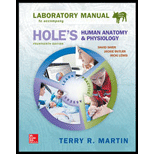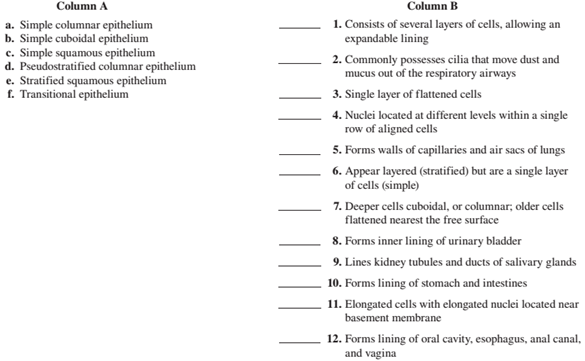
Concept explainers
Match the tissues in column A with the characteristics in column B. Place the letter of your choice in the space provided. (Some answers may be used more than once.)

To match:
The term from column A to the correct description in the column B.
INTRODUCTION:
In the complex body of the organisms which are multicellular in nature, different group of cells forms a tissue which performs various functions of the body like digestion, respiration, excretion etc. There are many cells and cellular layers which can be uni-layered or multi-layered,present in the body. Various tissues like epithelial tissue, connective tissue, muscular tissue and neural tissue are present in the multicellular organisms.
Answer to Problem 1.1A
The table below represents the correct match from the Column A to Column B.
| Column A | Column B | ||
| a. | Simple columnar epithelium | 7. 10. 11. | Deeper cells cuboidal, or columnar; older cells flattened nearest the free surface Forms lining of stomach and intestines Elongated cells with elongated nuclei located near basement membrane. |
| b. | Simple cuboidal epithelium | 9. | Lines kidney tubules and ducts of salivary glands |
| c. | Simple squamous epithelium | 3. 5. | Single layer of flattened cells Forms walls of capillaries and air sacs of lungs |
| d. | Pseudostratified columnar epithelium | 2. 4. 6. | Commonly possess cilia that move dust and mucus out of the respiratory airways Nuclei located at different levels within a single row of aligned cells Appeared layered (stratified) but are single layer of cells (simple) |
| e. | Stratified squamous epithelium | 12. | Forms lining or oral cavity, esophagus, anal canal, and vagina |
| f. | Transitional epithelium | 1. 8. | Consists of several layers of cells, allowing an expandable lining Forms inner lining of urinary bladder |
Explanation of Solution
- Simple columnar epithelium is a single layer lining. The term simple itself identifies it as a single layer and because it has slender, wider and comparatively longer cells hence the name columnar.It has microvilli on it in intestine and helps in more absorption and digestion of food particles also it is secretive in function because of which it helps in digesting food in the stomach by secreting digestive juices.
- Simple cuboidal epithelium as the name suggests has cells which are like cube in shape and it is also commonly found single layered only. It lines the glandular organs like kidney, liver, salivary glands etc. It helps in secreting various substances which helps in filtering blood in the kidney. Hence it also has secretory function.
- Simple squamous epitheliumhas flat, rounded and small cells with nucleus being placed centrally. They are not having a proper outline of the cell. They being thin cells helps in diffusion of various substances like air from respiratory tracts i.e. air sacs of lungs and also from blood vessels.
- Pseudostratified columnar epithelium is named so because the cells have nucleus at different levelswhich makes it appear as multi layers are present which is not actually true. The cells at free surface possess cilia which help in movement of mucous and prohibit foreign particles from entering the tract.
- Stratified squamous epitheliumis named so because strata mean layers, here the cells are actually arranged in layers so it’s a multilayered epithelium. The cells are lined upon as stacks. Its mainly responsible for the protection of our body from wear and tear. Therefore, it lines oral cavity, vagina, anal canal and so because at these places a lot of friction and trauma may occur which may result into injury of the underlying tissue.
- Transitional epitheliumis named so because this epithelium has cells which can undergo changes in their shape upon stress or distension. Therefore, it lines the urinary bladder. Upon urinary bladder being full, this epithelium can expand and when the bladder gets empty, the cells again can contract and regain their original shape.
Want to see more full solutions like this?
Chapter 8 Solutions
Laboratory Manual for Holes Human Anatomy & Physiology Fetal Pig Version
Additional Science Textbook Solutions
Biological Science (6th Edition)
Genetics: From Genes to Genomes
Campbell Essential Biology (7th Edition)
HUMAN ANATOMY
Chemistry: A Molecular Approach (4th Edition)
- Molecular Biology Please help and there is an attached image. Thank you. A bacteria has a gene whose protein/enzyme product is involved with the synthesis of a lipid necessary for the synthesis of the cell membrane. Expression of this gene requires the binding of a protein (called ACT) to a control sequence (called INC) next to the promoter. A. Is the expression/regulation of this gene an example of induction or repression?Please explain:B. Is this expression/regulation an example of positive or negative control?C. When the lipid is supplied in the media, the expression of the enzyme is turned off.Describe one likely mechanism for how this “turn off” is accomplished.arrow_forwardMolecular Biology Please help. Thank you. Discuss/define the following:(a) poly A polymerase (b) trans-splicing (c) operonarrow_forwardMolecular Biology Please help with question. Thank you in advance. Discuss, compare and contrast the structure of promoters inprokaryotes and eukaryotes.arrow_forward
- Molecular Biology Please help with question. Thank you You are studying the expression of the lac operon. You have isolated mutants as described below. In the absence of glucose, explain/describe what would happen, for each mutant, to the expression of the lac operon when you add lactose AND what would happen when the bacteria has used up all of the lactose (if the mutant is able to use lactose).1. Mutations in the lac repressor gene that would prevent the binding of lactose2. Mutations in the lac repressor gene that would prevent release of lactose once lactose hadbound3. Normally the lac repressor gene is located next to (a few hundred base pairs) and upstreamfrom the lac operon. Mutations in the lac repressor gene that move the lac repressor gene 100,000base pairs downstream.4. Mutations in the lac operator that would prevent binding of lac repressorarrow_forwardYou have returned to college to become a phylogeneticist. One of the first things you wish to do is determine how mammals, birds, and reptiles are related. Like any good scientist, you need to consider all available data objectively and without a preconceived “correct” answer. In pursuit of that, you should produce a phylogenetic tree based only on morphological features that show birds and mammals are more closely related. You will then produce a totally different tree, also using morphological features, that shows birds and reptiles are more closely related. Do not forget to include all three groups in both your trees. Based solely off the trees you produce, which relationship would you consider the more likely and why? Once you have answered that question, provide a brief summary of the “modern” understanding of the relationship between these three groups.arrow_forwardtrue or false, the reason geckos can walk on walls is hydrogen bonding between their foot pads and the moisture on the wall.arrow_forward
- Biology laboratory problem Please help. thank you You have 20 ul of DNA solution and 6X DNA loading buffer solution. You have to mix your DNA solution and DNA loading buffer before load DNA in an agarose gel. The concentration of the DNA loading buffer must be 1X in the DNA and DNA-loading buffer mixture after you mix them. For that, I will add _____ ul of 6X loading buffer to the 20 ul DNA solution.arrow_forwardBiology lab problem To make 20 ul of 5 mM MgCl2 solution using 50 mM MgCl2 stock solution and distilled water, I will mix ________ ul of 50 mM MgCl2 solution and ________ ul of distilled water. Please help . Thank youarrow_forwardBiology Please help. Thank you. Biology laboratory question You need 50 ml of 1% (w/v) agarose gel. Agarose is a powder. How would you make it? You can ignore the volume of agarose powder. Don't forget the unit.TBE buffer is used to make an agarose gel, not distilled water. I will add _______ of agarose powder into 50 ml of distilled water (final 50 ml).arrow_forward
- An urgent care center experienced the average patient admissions shown in the Table below during the weeks from the first week of December through the second week of April. Week Average Daily Admissions 1-Dec 11 2-Dec 14 3-Dec 17 4-Dec 15 1-Jan 12 2-Jan 11 3-Jan 9 4-Jan 9 1-Feb 12 2-Feb 8 3-Feb 13 4-Feb 11 1-Mar 15 2-Mar 17 3-Mar 14 4-Mar 19 5-Mar 13 1-Apr 17 2-Apr 13 Forecast admissions for the periods from the first week of December through the second week of April. Compare the forecast admissions to the actual admissions; What do you conclude?arrow_forwardAnalyze the effectiveness of the a drug treatment program based on the needs of 18-65 year olds who are in need of treatment by critically describing 4 things in the program is doing effectively and 4 things the program needs some improvement.arrow_forwardI have the first half finished... just need the bottom half.arrow_forward
 Medical Terminology for Health Professions, Spira...Health & NutritionISBN:9781305634350Author:Ann Ehrlich, Carol L. Schroeder, Laura Ehrlich, Katrina A. SchroederPublisher:Cengage Learning
Medical Terminology for Health Professions, Spira...Health & NutritionISBN:9781305634350Author:Ann Ehrlich, Carol L. Schroeder, Laura Ehrlich, Katrina A. SchroederPublisher:Cengage Learning Comprehensive Medical Assisting: Administrative a...NursingISBN:9781305964792Author:Wilburta Q. Lindh, Carol D. Tamparo, Barbara M. Dahl, Julie Morris, Cindy CorreaPublisher:Cengage Learning
Comprehensive Medical Assisting: Administrative a...NursingISBN:9781305964792Author:Wilburta Q. Lindh, Carol D. Tamparo, Barbara M. Dahl, Julie Morris, Cindy CorreaPublisher:Cengage Learning





